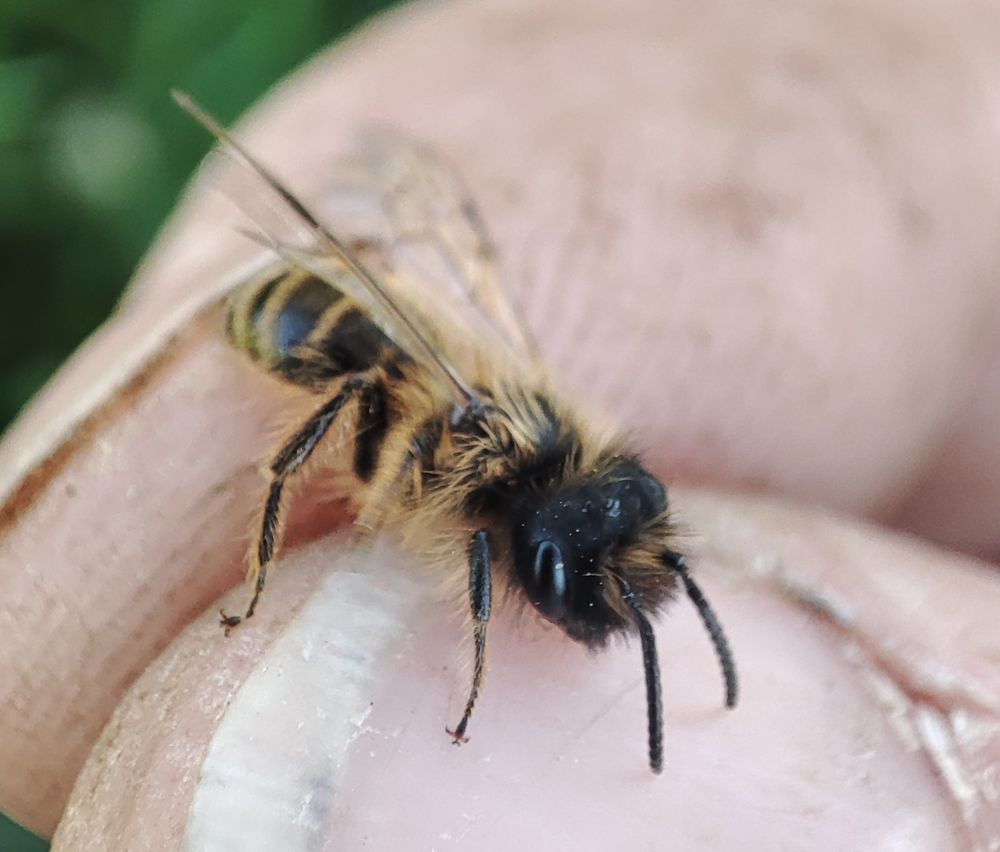
Former sea turtle biologist.
Nominative determinism


It highlights for me, one of most important and overlooked habitats for the majority of our solitary bees and wasps: seemingly boring bits of patchy ground. These are invaluable for so many important species



It highlights for me, one of most important and overlooked habitats for the majority of our solitary bees and wasps: seemingly boring bits of patchy ground. These are invaluable for so many important species
A species that nests in slightly looser sections of our hoggin paths and now in the mounds of sandy ballast we introduced (from skip salvaging)



A species that nests in slightly looser sections of our hoggin paths and now in the mounds of sandy ballast we introduced (from skip salvaging)
(Black Mining bee). This male was just about enough to separate from nigrospina.
A v.pleasing record from last 2 yrs.
We knew they were a few miles away but with the introduction of local, fine sands into the garden (natural soil is heavy clay), we now have them on site, it seems.




(Black Mining bee). This male was just about enough to separate from nigrospina.
A v.pleasing record from last 2 yrs.
We knew they were a few miles away but with the introduction of local, fine sands into the garden (natural soil is heavy clay), we now have them on site, it seems.
If my ID is correct, they are 𝐵𝑟𝑎𝑐ℎ𝑦𝑚𝑒𝑟𝑖𝑎 𝑡𝑖𝑏𝑖𝑎𝑙𝑖𝑠 endoparasitoids of Burnett moth larvae. We have lots of Knapweed & Burnett moth on site, so it does make sense.
South Essex.




If my ID is correct, they are 𝐵𝑟𝑎𝑐ℎ𝑦𝑚𝑒𝑟𝑖𝑎 𝑡𝑖𝑏𝑖𝑎𝑙𝑖𝑠 endoparasitoids of Burnett moth larvae. We have lots of Knapweed & Burnett moth on site, so it does make sense.
South Essex.
(First chimneys spotted June 7th.
Host spotted June 22nd, looking to be at the end of its life. Cuckoo spotted June 28th).
June 28th, 2024. Hilldrop, South Essex


(First chimneys spotted June 7th.
Host spotted June 22nd, looking to be at the end of its life. Cuckoo spotted June 28th).
June 28th, 2024. Hilldrop, South Essex













@theorchardproject.bsky.social @rhulbiology.bsky.social


@theorchardproject.bsky.social @rhulbiology.bsky.social
𝑂𝑠𝑚𝑖𝑎 𝑠𝑝𝑖𝑛𝑢𝑙𝑜𝑠𝑎 (Spined Mason bee)
This one is a male and you can just about see the spine/barb on Sternite 1, on photos 2 and 4. It also has the 10+ little teeth on the edge of tergite 6.
Salisbury Plain. June 30th, 2024.




𝑂𝑠𝑚𝑖𝑎 𝑠𝑝𝑖𝑛𝑢𝑙𝑜𝑠𝑎 (Spined Mason bee)
This one is a male and you can just about see the spine/barb on Sternite 1, on photos 2 and 4. It also has the 10+ little teeth on the edge of tergite 6.
Salisbury Plain. June 30th, 2024.
𝑃𝑠𝑒𝑢𝑑𝑜𝑚𝑎𝑙𝑢𝑠 𝑎𝑢𝑟𝑎𝑡𝑢𝑠
August, 2024



𝑃𝑠𝑒𝑢𝑑𝑜𝑚𝑎𝑙𝑢𝑠 𝑎𝑢𝑟𝑎𝑡𝑢𝑠
August, 2024
2 mm long. 1mm wide.
Anyone have a rough idea?

2 mm long. 1mm wide.
Anyone have a rough idea?
Eden Nature Garden, London. March 30th, 2024

Eden Nature Garden, London. March 30th, 2024
About to fly...

About to fly...
October 2024. Camden, North London, UK

October 2024. Camden, North London, UK
(Very likely to be a non-European species, I'm informed)

(Very likely to be a non-European species, I'm informed)


You can just about see the 'stylop' (a family of endoparasites) sticking out of the abdomen. Stylops can cause the female bees to have male and female characteristics, as I understand it.
It can also make ID trickier.


You can just about see the 'stylop' (a family of endoparasites) sticking out of the abdomen. Stylops can cause the female bees to have male and female characteristics, as I understand it.
It can also make ID trickier.
Epeolus sp. I found in amongst an aggregation of Ivy bees this September. Species very likely to be Epeolus variegatus but no voucher taken to be 100%


Epeolus sp. I found in amongst an aggregation of Ivy bees this September. Species very likely to be Epeolus variegatus but no voucher taken to be 100%
Eden Nature Garden, Clapham, London. April, 2024

Eden Nature Garden, Clapham, London. April, 2024
Beddington Park, April 2024


Beddington Park, April 2024

